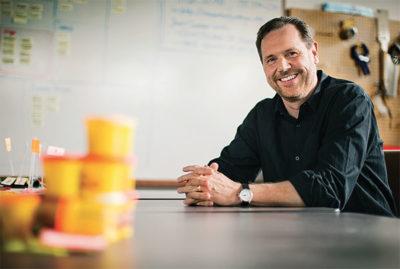Sebastian Fixson is an optimist. He needs to be. The classroom isn’t a place for despair and resignation. “As a teacher, you have to be an optimist,” says the associate professor of technology and operations management. “If you don’t believe it’s possible to make the world a better place, then why would you work in education?”

Photo: Webb Chappell
Sebastian Fixson
That optimism also stems from Fixson’s passion for design and innovation. The world may have many problems, he says, but designers dream and tinker to figure out how to solve them. A better way—that’s what designers seek. “I think designers are inherently optimists,” he says. “A designer wants to create solutions to improve lives.”
A researcher of new product development, Fixson teaches two product design classes, one for undergrads and one for grads, but admits that he didn’t always plan to become a professor. Born and raised in Germany, Fixson was inspired by American higher education when he came to MIT for his PhD. Interactions between professors and students were far more collaborative than what he had seen in Germany, so much so that he scrapped his original plan, which was to work in industry after graduation, and entered academia. After teaching stints at University of Michigan, MIT, and Northeastern University, he came to Babson in 2008.
Fixson thinks a lot about what makes for good design. “It doesn’t have to be fancy or complicated,” he says. Ask him for examples, and he’ll rave about a unique teaspoon from an Italian product design company and pull up its image on his computer, showing how the spoon’s hollow handle can drain a tea bag. He’ll also point to the sleek desk lamp in his Tomasso Hall office. Most of us don’t dwell on the fine details of desk lamps, but Fixson picked his based on various criteria. He likes how the lamp shines brightly and broadly despite its narrow design, and he also likes how it uses LED bulbs, which are long lasting and energy efficient. For him, the lamp is a nice mix of form and function.
Like many, Fixson also admires the simplicity of Apple products. Remember the first time you used an iPod and its click wheel to scroll through your music? Remember how easy and right it seemed, how natural? “One of the reasons Apple products are so successful is they’re intuitive,” he says.
Fixson covers a lot of ground in his product design classes. In just three months, he takes students through the design process, from identifying a problem or opportunity, to generating ideas to address it, to prototyping. In last year’s MBA product design course, student teams created a dog toy, biodegradable urn, women’s shoe with adjustable heel, and a kit for home brewers to clean their beer bottles.
“What the classes teach is the design process itself, which is useful for any innovation project, be it in a new venture, an existing company, or a nonprofit,” Fixson says. “It gives students an appreciation of how to create anything.” Indeed, the flexibility and potency of this process is shown in another Fixson class, “Social Entrepreneurship by Design,” in which students use the design process to create services addressing social issues.
Fixson teaches his design courses in Olin 125, otherwise known as the Romper Room. The room is stocked with arts and crafts supplies that wouldn’t be out of place in a grade school classroom. There are markers, Popsicle sticks, pipe cleaners, tape, and lots of Play-Doh. He keeps cans of the putty in his office, too. “Once people have it in their hands, they want to play around with it and think about ideas,” he says. Concepts that students have percolating in their heads can be fuzzy and hard to articulate, so they can use the art supplies to create rough models of their thoughts. “They’re not meant to look perfect, or even look real,” he says. “They’re meant to convey an idea.”
Good design, though, involves more than just playing with Play-Doh. In his office, Fixson keeps a list taped to the wall of the qualities that are invaluable for the design process: empathy, integrative thinking, experimentation, collaboration, and, not surprisingly, optimism. Of these, empathy is particularly important and something he stresses to students. As they create products, designers must become almost psychoanalysts to understand the lives and concerns of those they’re trying to help. “All organizations have an increasing need to innovate in order to survive,” he says. “The success of any product or service hinges on whether it matches the user’s needs. And the only way to find this match is to invest time and attention to understand users.”
As an example, he points to the work of a design firm creating a new insulin pump for diabetics. The designers focused on the feelings of the children using the old treatment, which was cumbersome and impossible to hide. “Think about what it means to a kid,” Fixson says. “It suggests to the world you’re different.” The end result was a much smaller and less intrusive device. To Fixson, this is what good design is all about. “I find that very satisfying,” he says.
